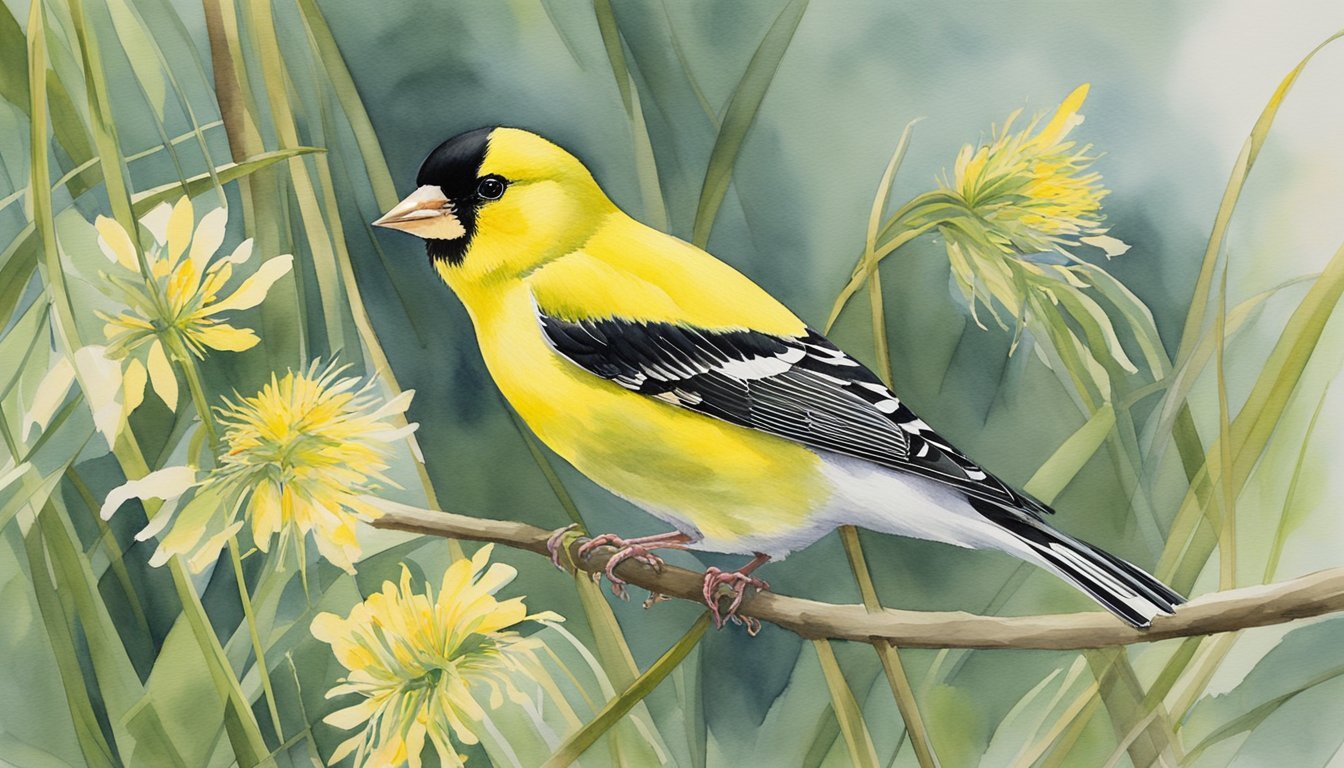Understanding the Willow Goldfinch
The Willow Goldfinch, or American Goldfinch, is a vibrant bird known for its striking coloration and joyful song. This section details its physical features, natural habitats, and feeding behavior.
Physical Characteristics of the Willow Goldfinch
Size and Shape: The American Goldfinch, scientifically named Spinus tristis, is a small bird with a conical beak suited for its granivore diet. Adult goldfinches have a body length of about 11 to 14 cm (4.3 to 5.5 inches), with a wingspan ranging from 19 to 22 cm (7.5 to 8.7 inches).
Coloration: During the breeding season, the male Willow Goldfinch boasts a bright yellow body contrasted with black wings, a black tail, and a black cap atop its head. Females and males outside of the breeding season have a more subdued olive or brownish coloration.
Habitat and Range
Natural Habitats: These birds are often found in a variety of treed and shrubby habitats, including gardens, orchards, and along roadsides. North America serves as the home for the Willow Goldfinch, where it can be seen across fields and backyards from coast to coast.
Adaptation to Environment: Goldfinches are adaptable, adjusting to various habitats but showing a preference for areas with a plentiful supply of trees and shrubs, such as asters, thistles, and sunflowers, which also provide food sources.
Dietary Habits
Primary Diet: Known as a granivore, the goldfinch primarily feeds on seeds. Key components of its diet include the seeds from sunflowers, asters, and thistles, aligning with its habitat preferences.
Foraging Behavior: The Willow Goldfinch forages in flocks and is particularly adept at feeding while perched on the seed heads of flowers or in shrubs. Outside of breeding season, they also frequent feeders, becoming a charming addition to many a backyard feeder scene.
For more details on the state symbol status and historical background, learn about how the Willow Goldfinch became the official bird of Washington.
Discover more about how these birds congregate and socialize while foraging in Meet the charming Goldfinch: Washington State’s beloved bird.
Find further insights into the bird’s breeding season appearance and distinct plumage changes on the Washington State Bird | Willow Goldfinch (American Goldfinch) page.
What Unique Traits Does the Willowgoldfinch Share with the Rockhopper Penguin?
The Willowgoldfinch, with its vibrant plumage and social nature, contrasts sharply with the Rockhopper Penguin’s distinct looks and bold personality. However, both exhibit remarkable adaptability in their environments. Exploring the rockhopper penguin species traits reveals a fascinating resilience, showcasing how diverse avian life can thrive in various habitats.
Behavior and Reproduction

The American Goldfinch, often referred to as the willow goldfinch in Washington, demonstrates intricate behaviors and reproduction patterns marked by specific seasonal behaviors, migratory habits, and distinctive courtship rituals.
Breeding and Nesting Behavior
American Goldfinches engage in a late breeding season, timing it with the abundance of plant down required for nesting. The males are known for their vibrant yellow plumage during the breeding season and courtship displays that include aerial maneuvers and a distinctive po-ta-to-chip song. Females, less conspicuous in color, take the lead in nest building, selecting the location and constructing the nest with plant down, weeds, and other soft materials. Their nests are usually well-crafted cups shaped from the materials they gather.
The nesting behavior of these birds reflects their need for a steady supply of seeds. As they are monogamous during the breeding season, the male closely guards the female and the territory around the nest. Once the eggs are laid, the female incubates them for about two weeks, during which time the male may feed her.
Seasonal Changes and Migration
American Goldfinches are migratory, traveling in flocks from areas as north as Alberta to North Carolina during breeding months, and then southward in the winter. Their flight patterns are distinctive and described as bouncy, which makes their migrations quite noticeable.
With the change of seasons, these birds also undergo a complete molt, replacing their bright breeding colors with a more subdued brownish tone. This change in plumage coincides with the seasonal shifts in their feeding habits and migration. Active and acrobatic, the Goldfinches adapt their flight patterns and behavior to each season’s challenges, ensuring their survival and reproductive success. Notoriously hardy, they continue to grace the skies and backyards well into the cooler months, and as state birds of Washington, Iowa, and New Jersey, they hold a place of affection and prominence in these states.

